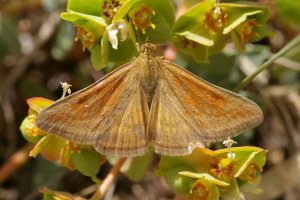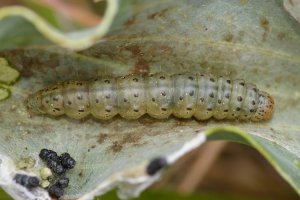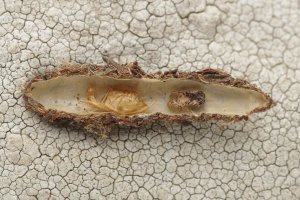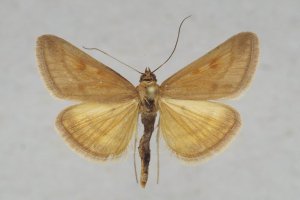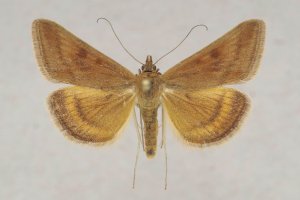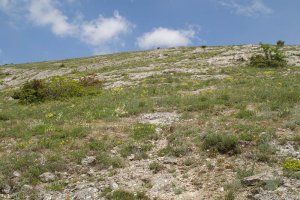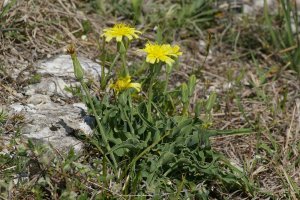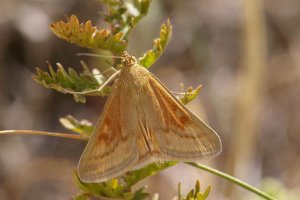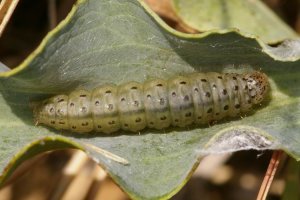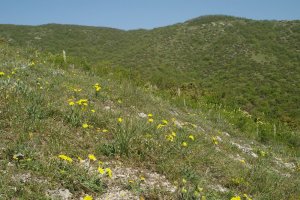

 +4Kontinente:EUAS
+4Kontinente:EUAS1. Lebendfotos
1.1. Falter
1.2. Raupe
1.3. Puppenkokon
3. Biologie
3.1. Habitat
3.2. Raupennahrungspflanzen
3.3. Nahrung der Raupe
- [Asteraceae:] Scorzonera crispa [= Scorzonera austriaca ssp. crispa]
ZU "Pyrausta shirazalis" gab es keine Angaben zur Biologie. Gemäß der Erstbeschreibung der "Loxostege ayhanana" aus dem Osten der Türkei (Kemal & Koçak (2017)) war die Nahrung der Raupe zunächst ebenfalls unbekannt. Savchuk & Kajgorodova (2018) konnten hingegen schon kurz darauf für die Krim berichten: "Under natural conditions, the larvae were found on Scorzonera crispa M. Bieb. We did not find any early-instar larvae. The last-instar larvae live concealed in leaves spun into tubes around the central vein. Such shelter is laid with silk on the inside. The feeding damage was also recorded on the leaves of the host plant. Collected larvae ceased feeding between the end of July and early August. Fully grown caterpillars make thin white tubular cocoons in the soil, 30–35 mm in length (Fig. 12), in which they hibernate until spring, and pupate afterwards. In captivity, the pupation took place in May, with adults emerging in early June."
Scorzonera crispa wird in der Flora Europaea, Volume 4 (Tutin et al. 2010) noch als Scorzonera austriaca ssp. crispa geführt und soll demnach in Europa nur auf der Krim vorkommen. Mit dem Nachweis des Falters in Nordmazedonien müsste die Art noch eine weitere Nahrungspflanze nutzen.
4. Weitere Informationen
4.1. Etymologie (Namenserklärung)
Der Name "shirazalis" leitet sich vom Typenfundort "Shiraz" in der Provinz Fars im Iran ab.
Die Namensvergabe des Synonyms "ayhanana" war zumindest ungewöhnlich. Vielleicht darf man hier eine politische Solidarisierung mit dem Volk der Uiguren hineininterpretieren. Jedenfalls erläutern Kemal & Koçak (2017): “The scientific name of this new species is dedicated to Mrs. Ayhan Turdi (1882-1942), nickname “Ayhan Ana”. She was born in a wealthy and educated family in Kuldja (Uighur A.R.) Her father provided Ayhan’s training in one of the innovative school. This educational opportunity has been influential in her growing up as one of the contemporary intellectual thinkers. After her father, she lost her mother and her beloved partner in a row, never married again. She has opened up a 16-room house for orphans as a boarding school for all their expenses. This school was known as “Hayriye Mektebi [Beneficial School] at that time and “Ayhan Ana [mother] School”, which is known as Ayhan Ana name among the public day by day […] This school, which has undertaken important tasks in educational services, has been a science nest for tens of thousands of children and still works actively”.
4.2. Andere Kombinationen
- Pyrausta shirazalis Amsel, 1961 [Originalkombination]
4.3. Synonyme
- Loxostege ayhanana Kemal & Koçak, 2017 [synonymisiert durch Yepishin (2022)]
4.4. Taxonomie und Faunistik
Loxostege ayhanana wurde erst 2017 nach 3 Männchen aus der Osttürkei beschrieben; locus typicus ist Çatak, Darboðaz 2050m in der Van Provinz. Savchuk & Kajgorodova (2018) wiesen Falter und Raupen an 5 Fundorten auf der Krim nach.
Bei der Neuaufstellung der alten Pyraloidea-Sammlung von Amsel im Naturkundemuseum Karlsruhe (SMNK) durch Viktor Yepishin zeigte sich, dass "Pyrausta shirazalis Amsel, 1961" in die Gattung Loxostege gehört, also neu zu Loxostege shirazalis (Amsel, 1961) kombiniert werden musste. Ferner fiel große Ähnlichkeit von "Pyrausta shirazalis Amsel, 1961" mit Loxostege ayhanana auf, die schließlich zum Schluss führte, dass Loxostege ayhanana Kemal & Koçak, 2017, jüngeres Synonym von Loxostege shirazalis (Amsel, 1961) ist.
Yepishin (2022: 448) schreibt zur aktuellen Kenntnis des Verbreitungsbilds: "covers North Macedonia (Modrište, 17.VI.2016, I. Richter leg.; unpublished data), Ukraine (the Crimea), Turkey (Van Prov.) and Iran (Fars Prov.)."
4.5. Typenmaterial
Yepishin (2022: 448) untersuchte die beiden Typen und schrieb zu ihnen: "Holotype of Pyrausta shirazalis, 1♂ (Figs 2–3), “HoloTypus ♂ | leg. H. Amsel || Pyrausta | shirazalis [on the reverse]”, “Iran, Shiraz | 7000 ft. 12.5.40 | E. P. Wiltshire”, “GU | 3595”. Paratype of Pyrausta shirazalis, 1♀, (Figs 1, 4), “AlloTypus ♀ | leg. H. Amsel || Pyrausta | shirazalis [on the reverse]”, “SHIRAZ | 12.5.40”; prep. no. ♀599.21 (slide) V. Yepishin."
"Loxostege ayhanana": Kemal & Koçak (2017) berichten: "Holotype ♂, East Turkey, Van Pr. Çatak, Darboðaz 2050m (65 Dg), 8 6 2015; Paratypes: 1 ♂ from same place, 2030m, 30 6 2016; 1 ♂ from Bahçesaray, Upper Mukus valley 1840m (65Am4), 23 6 2016, M. Kemal & A. Koçak leg. […]. Biorepository: CESA”.
(Autoren: Erwin Rennwald & Jürgen Rodeland)
4.6. Literatur
- Erstbeschreibung: Amsel, H. G. (1961): Die Microlepidopteren der Brandt'schen Iran-Ausbeute. 5. Teil. — Arkiv för Zoologi N. S. 13 (17): 323-445, pl. I-IX.
- Beschreibung als Loxostege ayhanana: Kemal, M. & A. Ö. Koçak (2017): Description of a new species, Loxostege ayhanana sp. n. from East Turkey (Lepidoptera, Pyraloidea). — Miscellaneous Papers (Centre for Entomological Studies Ankara) 164: 1-5 [Digitalisat auf archive.org].
- Kızıldağ, S. (2020): Molecular evaluation of the phylogenetic position of Loxostege ayhanana Kemal & Koçak, 2017 from East Turkey (Lepidoptera: Crambidae, Pyraustinae). — SHILAP Revista de Lepidopterología 48 (189): 39-45. [PDF auf redalyc.org]
- Savchuk, V.V. & N.S. Kajgorodova (2018): The first record of Lostege ayhanana Kemal et Koçak, 2017 (Lepidoptera: Crambidae) from the Europe, with notes on its bionomy. — Кавказский Энтомологический Бюллетень 14 (1): 83-85 [PDF auf lepido.ru].
- Tutin, T.G., Heywood, V.H., Burges, N.A., Moore, D.M., Valentine, D.H. Walters, S.M. & D.A. Webb [ed.] (2010): Flora Europaea. Volume 4. Plantaginaceae to Compositae (and Rubiaceae). [first published 1976, sixth printing 2006, first paperback printing 2010]. - 505 p.; Cambridge (Cambridge University Press).
- Yepishin, V. (2022): A new synonym of the Pyraloidea from the genus Loxostege Hübner, 1825 (Lepidoptera: Crambidae: Pyraustinae). — Zootaxa, 5134 (3): 448–450.
4.7. Informationen auf anderen Websites (externe Links)
- [Бабочки Крыма – Lepidoptera of Crimea von Vladimir Savchuk] [Seite aktuell leider nicht erreichbar]





